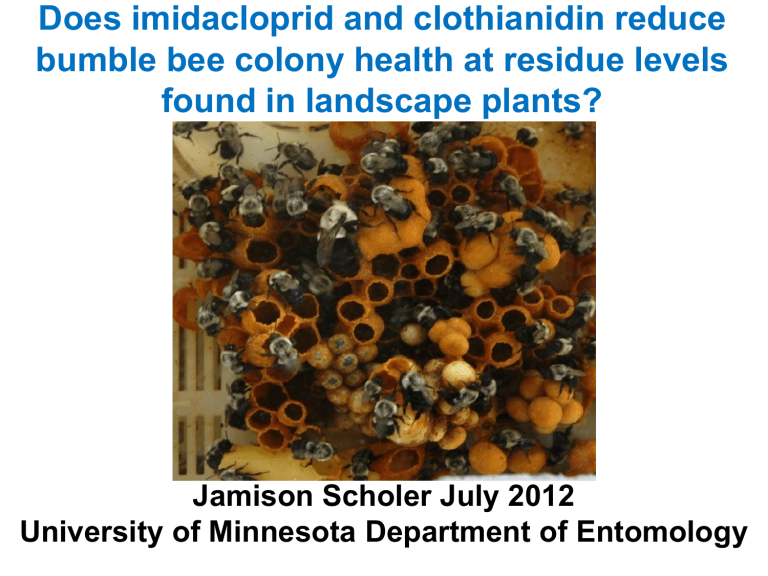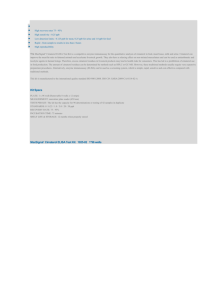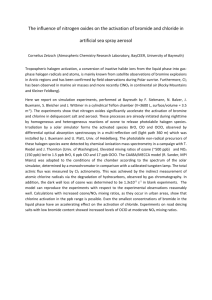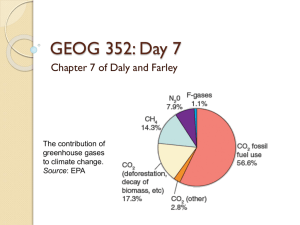Duluth 2012 Scholer

Does imidacloprid and clothianidin reduce bumble bee colony health at residue levels found in landscape plants?
Jamison Scholer July 2012
University of Minnesota Department of Entomology
Beekeepers
Petition for clothianidin to be withdrawn from sale
Registration was based on a Bayer study that was later found by beekeepers to be deficient and later EPA agreed
(Feldman et al. 2010) .
Insecticide seed coating dust extremely toxic to bees, new studies with clear evidence (Krupke et al. 2012, Tapparo et al. 2012,
Marzaro et al. 2011) .
Insecticide use contributes to weakened immune system increased susceptibility to pathogens.
(Alaux 2010, Hawthorne & Dively 2011, Pettis et al. 2012) .
lovethehoneybees.blogspot.com
Neonicotinoids: Trade offs
Advantages:
Neonicotinoids most often applied to the soil and are translocated through the entire plant
Variety of application methods: soil drench, irrigation, seed treatment, tree injection
Safer to mammals and birds (selective-binding to insects)
Disadvantages:
Neonicotinoids most often applied to the soil and are translocated to pollen and nectar
Harmful against all beneficial insects eating pollen, nectar
Long lasting residual effects in pollen, nectar, leaves, soil
Bayer argues 20 ppb imidacloprid will not affect mortality, but will affect behavior.
Neonicotinoid: Use in Minnesota 2009
Active Ingredient in (lbs)
Industry
Crop chemicals
Turf / ornamental
Garden and lawn
Structural
Animal care
Industrial, forestry
Home
Total use imidacloprid
46,766
3,095
1,636
1,591
63
13
9
53,173 lbs clothianidin
19,347
95
12
0
0
0
0
19,454 lbs
Minnesota Department of Agriculture
Neonicotinoid: Products
Active Ingredient acetamiprid clothianidin
Trade Name
Tristar, Assail
Poncho, Arena dinotefuran imidacloprid
Scorpion, Safari
Gaucho, Marathon, Merit, Admire thiacloprid Calypso thiamethoxam Actara, Adage, Crusier
Neonicotinoids: Persistence in the environment
Active ingredient Soil half-life (days) clothianidin
Reference
148 - 1,155 EPA (2003) imidacloprid 40 - 997 NPIC (2010)
Neonicotinoid: Toxicity to bees
zmescience.com
Mode of Action:
Over stimulates nicotine receptors in central nervous system
Active Ingredient
(Acute) clothianidin
(Acute) imidacloprid
(Chronic) clothianidin
(Chronic) imidacloprid
Oral *LD
50 ng/bee in 10µL
3.8
ppb
(ng/.1g bee) Reference
38 European
Commission (2005)
4 - 41
No Data
0.01-1.0
40-410 Marletto (2003)
No Data No Data
0.1-10 Suchail et al. (2001)
*Lethal dose to 50 percent of population
Neonicotinoids: imidacloprid residue levels
Sunflower
(seed treatment)
Pumpkin
(soil drench, irrigation)
Buckwheat
(soil drench)
Horse chestnut tree
(trunk injection)
Cornelian cherry
Serviceberry
(soil drench) ppb
2 nectar
4 pollen
4 - 12 nectar
37 - 87 pollen sampling Reference
At bloom
At bloom
Schmuck et al.
2001
Dively & Hooks
2010
15- 27 nectar 21 days Krischik 2007
5-283 blossom 7 days Maus et al. 2004b
1,038- 2,816
66-4,560 blossom
540 days Doering et al.
2005a,b
Experimental hypothesis
Imidacloprid and clothianidin used at landscape rates will negatively affect colony health.
Objectives
Determine the effects of landscape rate use of imidacloprid and clothianidin on Bombus impatiens colony health.
1. Treat colonies with a range of imidacloprid and clothianidin doses for a summer (11 weeks).
2. Determine the effect of dose on colony health.
Methods: Experimental design
5 treatments
(0, 10 , 20 , 50 , 100 ppb)
4 colonies / treatment
Repeat experiment 2 times imidacloprid Fall 2011 clothianidn Spring 2012
40 colonies / insecticide
Methods: Parameters measured
Bimonthly (3 times/experiment)
Colony weight
Biweekly
Individual worker weights (20 workers per colony)
Number of bees dead in flight box (separated by caste)
Weekly
Pictures of colony box looking at:
Number of brood cells
Number of bees
Number of honey pots
Number of empty cells
Queen status (dead or alive)
48 hour
Sugar syrup consumption
Methods: Neonicotinoid treatments
Treated syrup: Add neonicotinyl insecticide to 50% sugar syrup
Five Treatments (ppb)
0 ppb = control
10 ppb = pollen from seed treatments
20 ppb = NOEC from Bayer, but affects behavior
50 ppb = Field pumpkin study
100 ppb = Lower level found in landscape plants
EPA LD50 for imidacloprid 4-40 ng/bee
= 40-400 ppb
LD50 for clothianidin 3.8 ng/bee
= 38 ppb
Annual life cycle:
Bombus impatiens
Queen starts colony in May
Winter
Mating in fall
New queen + drone production in late summer
Bumble bee colonies in the greenhouse
Bumble bee colonies with flight box
Brood box Flight box
48 hr measurement of sugar syrup consumption from feeders
Sugar syrup consumption (Week 8)
100
90
80
70
60
50
40
30
20
10
0
A a
ANOVA: F = 22.2, df = 4, 35, p = 0.0001
ANOVA: F = 34.5, df = 4, 28, p = 0.0001
Imidacloprid Clothianidin
B b
BC c
C c
C c
0 100 10 20 50
Neonicotinoid (ppb)
Queen mortality (week 8)
100
90
80
70
60
50
40
30
20
10
0
Imidacloprid Clothianidin
1/8
0
3/8
2/9
7/8
5/8
10 20 50
Neonicotinoid (ppb)
8/8
100
6/9
Measurement of bee and colony weight
Mean individual bee weight (week 8)
0,18
0,16
ANOVA: F = 2.8, df = 4, 26, p = 0.05
ANOVA: F = 1.7, df = 4, 24, p = 0.18
Imidacloprid a
Clothianidin a
A a
0,14
AB a
0,12 AB
AB a
0,1
B
0,08
0,06
0,04
0,02
0
0 10 20 50
Neonicotinoid (ppb)
100
Mean colony weight (final)
300
250
200
150
100
50
0
500
450
400
350
A a
ANOVA: F = 16.2, df = 4, 35, p = 0.0001
ANOVA: F = 16.1, df = 4, 37, p = 0.0001
Imidacloprid Clothianidin
B a
BC b
C b
C b
0 10 20 50
Neonicotinoid (ppb)
100
Measuring nest development
Mean number of honey pots (final)
250 a
ANOVA: F = 5.3, df = 4, 35, p = 0.0020
ANOVA: F = 12.7, df = 4, 37, p = 0.0001
Imidacloprid Clothianidin
200
150 ab
100
A
50
0
0
AB
AB bc bc
B
10 20 50
Neonicotinoid (ppb)
B
100 c
Measuring number of bees produced
Bees collected
Flight box (Biweekly)
Colony dissection (End of experiment)
Males
Females
Queens
Total number adult bees produced (final)
600
ANOVA: F = 4.6, df = 4, 35, p< 0.0042
ANOVA: F = 4.6, df = 4, 35, p< 0.0042
Imidacloprid Clothianidin
500
A a
400
AB ab
AB ab
B
300 b
B b
200
100
0
0 10 20 50
Neonicotinoid (ppb)
100
Annual life cycle:
Bombus impatiens
Days egg to adult imidacloprid number of adults clothianidin number of adults
Queen 37
Worker 25
GH colony: 9-34
0 (ppb): 6
100 (ppb): 4
GH colony: 9-34
0 (ppb): 7
100 (ppb): 1
GH colony: 375-400 GH colony: 375-400
0 (ppb): 314 0 (ppb): 347
100 (ppb): 212 100 (ppb): 249
Male 25 GH colony: 9-95
0 (ppb): 135
100 (ppb): 4
GH colony: 9-95
0 (ppb): 64
100 (ppb): 2
Birkhäuser (2002), Fisher (1992)
Summary of preliminary results
Species Dose (AI),ppb
Bombus impatiens
10, 20, 50, 100
Parameter affected
Sugar syrup consumption
Queen mortality lower at 0 ppb
Bombus Label rate for impatiens grub control
(no irrigation)
Bombus terrestris
10, 20
Individual bee weight
Colony weight
Number of honey pots
Total number bees produced
Brood number
Number of honey pots
Worker number / weight
Colony nest weight
Worker number
Drone number (males)
Foraging activity
Reference
Current research
Hoffmann and Castle
2012
Mommaerts et al. 2010
Sugar Consumption Colony weight
Queen mortality Number of honey pots
Experimental hypothesis
Imidacloprid and clothianidin used in landscape rates will negatively affect colony health.
Objectives
Determine the effects of landscape rate use of imidacloprid and clothianidin on Bombus impatiens colony health.
1. Treat colonies with a range of imidacloprid and clothianidin doses for a summer (11 weeks).
2. Determine the effect of dose on colony health.
References
Alaux, C., Brunet, J.L., Dussaubat, C., Mondet, F., Tchamitchan, S., Cousin, M., Brillard, J., Baldy, A., Belzunces, L.P., Conte, Y.L.,
2010. Interactions between Nosema microspores and a neonicotinoid weaken honeybees ( Apis mellifera ). Environmental
Microbiology. 12, 774-782.
Cameron, S.A., Loziera, J.D., Strange, J.P., Koch, J.B., Cordesa, N.L., Solter, F., Griswold. T.L., 2010. Patterns of widespread decline in North American bumble bees. PNAS. Early Edition.
Cordes, N., Huang, W.F., Strange, J.P., 2012. Interspecific geographic distribution and variation of the pathogensNosema bombi and
Crithidia species in United States bumble bee populations. Journal of Invertebrate Pathology. 109, 209-216.
Feldman, 2010. Correspondence with the Environmental Protection Agency
Fisher, R.M., 1992. Sex ratios in bumble bee social parasites – support for queen-worker conflict theory? (Hymenoptera, Apidae).
Sociobiology 20: 205
–217.
Grixti, J.C., Wong, L.T., Cameron, S.A., Favret, C., 2009. Decline of bumble bees ( Bombus ) in the North American Midwest.
Biological Conservation. 142, 75-84.
Hawthorne, D.D., Dively, G.P., 2011. Killing them with kindness? In-hive medication may inhibit xenobiotic efflux transporters and endanger honey. PLOS ONE. 6(11).
Hoffmann, E.J., Castle, S.J., 2012. Imidacloprid in Melon Guttation Fluid: A Potential Mode of Exposure for Pest and Beneficial
Organisms. Economic Entomology. 105, 67-71.
Marzaro, M. Vivan, L., Targa, A., Mazzon, L., Mori, N., Greatti, M., Petrucco, T.E., DiBernardo, A., Giorio, C., Marton, D., Tapparo, A.,
Girolami, V., 2011. Lethal aerial powdering of honey bees with neonicotinoids from fragments of maize seed coat. Bulletin of
Insectology. 64, 119-126.
Mommaerts, V., Reynders, S., Boulet, J., Besard, L., Sterk, G., Smagghe, S.G., 2009. Risk assessment for side-effects of neonicotinoids against bumble bees with and without impairing foraging behavior. Ecotoxicology. 19, 207-215.
References
Tapparo, A., Marton, D., Giorio, C., Zanella, A., Solda, L., Marzaro, M., Vivan, L., Girolami, V., 2012. Assessment of the
Environmental Exposure of Honeybees to Particulate Matter Containing Neonicotinoids Insecticides Coming from Corn Coated
Seeds. Environ. Sci. Technol. 46, 2592-2599.
Whitehorn
, P.R., O’Connor, S., Wackers, F.L., Goulson, D., 2012. Neonicotinoid pesticide reduces bumble bee colony growth and queen production. Science. 336, 351-352.
Questions?
Acknowledgments
Dr. Vera Krischik (Advisor)
Karine Pouliquen (Lab supervisor)
Judy Wu
Dr. Ian Burns
Undergraduate help including
Tyler Obermoller
Rafael Boulton
Kristen Waurio
Funding Source
USDA Sustainable Agriculture Research and Education
Legislative-Citizen Commission on Minnesota Resources





